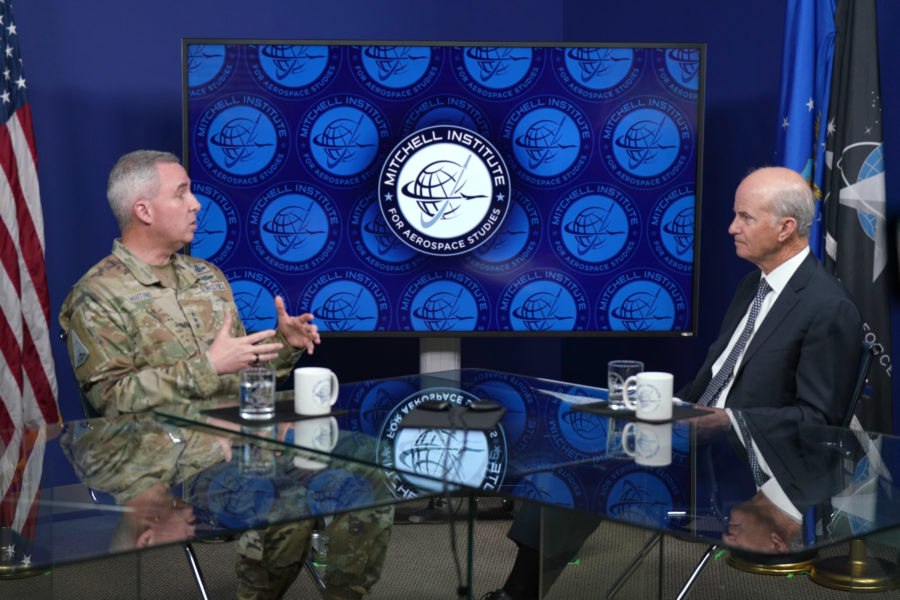With the Air Force giving up on aging intelligence, surveillance, and reconnaissance planes, the Space Force finds itself seeking a way to take on that mission—and defining the capabilities it needs to do so, the head of Space Operations Command said May 24.
Space-based ISR is ultimately seen as replacing airborne ISR for hitting mobile targets on the ground. ISR from space has traditionally been an intelligence function, but frequently unavailable in a timely way to military operators. That’s going to have to change, Lt. Gen. Stephen N. Whiting suggested during a Mitchell Institute for Aerospace Studies webinar.
The National Reconnaissance Office owns most of the government surveillance satellite technology and a rapidly expanding commercial industry is growing around space-based sensing, technologies that have aided Ukraine in its fight against Russia.
Where does that leave the Space Force?
“If we look at the other services, which have been around a lot longer than the Space Force, all of them have tactical Title 10 ISR capability that they retain or they present to a combatant command to execute missions on behalf of tactical warfighters,” Whiting said. “So as we think about that for the Space Force, it’s no different in the Space Force than the other domains, but we need to start by looking at what exists today.”
Whiting said the U.S. has the “world’s best” ISR capabilities today, between the NRO and industry, but having what’s best today isn’t the same as having what’s needed tomorrow.
“Whether it’s owned by the Space Force or we leverage these other two sets of capabilities in some unique way, all of that is in discussion right now,” Whiting said. But to fill the gaps between what the intelligence community can provide and what industry has to offer, it’s likely the Space Force will be the one to make up the difference.
“I just don’t think we should be concerned if we do land in a place that says ‘Hey, the Space Force will have retained capability for our own purposes to support tactical warfighting like the other services do,’” Whiting said. “But no decisions have been made, and those discussions are ongoing.”
Retired Gen. Kevin P. Chilton, Explorer Chair at the Mitchell Institute’s Spacepower Advantage Center of Excellence (MI-SPACE), said it makes sense for the Space Force to have its own “in-house” ISR capabilities to provide for the needs of combatant commanders around the world.
“There’s a reason it’s called National Reconnaissance—it’s not combatant commander reconnaissance,” said Chilton, who served as the head of Air Force Space Command and U.S. Strategic Command. “And my sense is the services’ job is to support the combatant commanders. That needs to be their No. 1 priority. When it’s a national asset, appropriately so, there are national requirements that could perhaps trump the requirements of a combatant commander, even when he or she is engaged.”
Whiting likewise noted the need to understand the requirements on the tactical edge—where warfighters are operating—suggesting there may be a gap the Space Force needs to fill.
“I think we’ve got to look at what capabilities are out there today and where the taskings are coming from, and then what’s ultimately getting to the tactical warfighter,” said Whiting. “And if between what’s in the National Reconnaissance enterprise and what’s in commercial, we need to develop something new, then we’ll figure that out where that command and control and tasking lies.”
The Space Force and NRO are closely aligned. USSF has an element within the NRO, and the agency’s deputy director is Space Force Maj. Gen. Christopher S. Povak. Figuring out how the two work together, connect, and interact—and how that fits with U.S. Space Command—has been an ongoing topic of discussion.
The Space Force and NRO collaborate on projects, including Silent Barker, which has been wrapped in secrecy. “We had a need on the Space Force side to develop a follow on to the Space-Based Space Situational Awareness satellite, SBSS, while at the same time the NRO had indications and warning requirements to help intelligence in [geosynchronous orbit],” Whiting said. “Well, we decided to work together and there’s a program called Silent Barker that’s going to get after both of those requirements. We have a joint program office in the NRO that is leading the development of that system. That will launch later this year.”
When Chilton asked if the Space Force will retain control over the Silent Barker satellite, Whiting demurred.
“In this case, it’s going to be more about the data. And so we will have access to all that data and the ability to use Silent Barker for our purposes.”
“But who gets to decide which way it’s looking?” Chilton asked.
“We will have a process to do that, and we’ve got a CONOPs with the NRO that indicates what it will be doing each and every day,” Whiting said.
Such prioritization and deconfliction processes are essential, Chilton noted, “unless you own and operate” the satellites in question.
